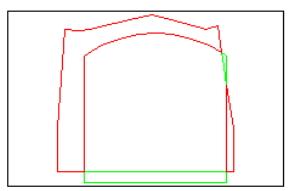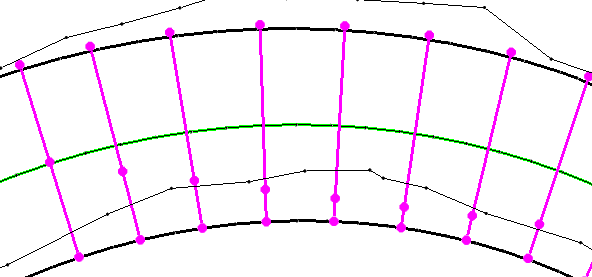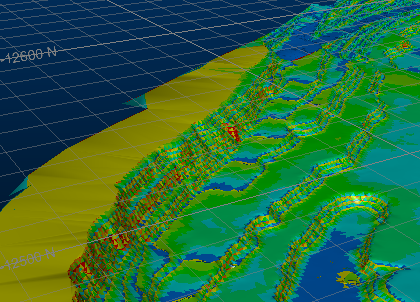Drive Compliance Report
To access this screen:
-
Activate the Reports ribbon and select Reports >> Underground >> Drive Compliance.
-
Run the command "survey-drive-compliance".
-
Use the quick keys 'sdc'
Report Overview
The main purpose of the Drive Compliance report is to assess the correlation of ground data for a given period versus the designed/expected outcome for the same survey period. This is with respect to:
- Material mined and planned.
- Material mined but not planned.
- Material planned but not mined.
As with other Studio Survey reports, the design and as-mined development volumes are selected according to date. This data will have been committed to the current database using the Add to Database tool.
For open pit compliance reporting, see:
Note: This tool supports batch processing: use Add to Batch to schedule processing at a later date, using the Run Batch task.
In the context of the Drive Compliance command, a Design Solid represents a volume indicating a target to be achieved at a given point in the future, potentially several reporting periods ahead. The resulting report shows the difference between the actual mined solid versus the designed solid , and is typically used to validate the extent of under- or overmining.
Any design solid can be selected (by its survey date). The solid must have been added to the current database as the Development Design Solids type for it to be selectable. See Add to Database (Underground).
The actual surveyed solid data can either be from the current database (an item added as Surveyed Solids) or loaded 3D data can be picked from a 3D window.
Drive Compliance Cuts & Profile Reporting
You can report drive extraction compliance at any point along a drive. Define the distance between 'cuts' (the Cut Length) and a profile is calculated at the halfway point between each cut, reporting over- and undermining at each point.
The cut length is measured along the centreline of each development drive (these centreline strings are specified as Design Strings).
For example, in the image below, the pink lines represent the 'cuts' that define the drive segments that are profiled for area variance reporting:
The thin grey line represents a slice through the surveyed drive and the thicker black line the designed solid for the same reporting period. The centreline (design string) is shown in green.
A typical profile report, taken at the halfway point between cuts, could look like this:

In this case, the overbreak is shown in red and the underbreak in green.
Note: trivial cuts under 1 measurement unit at the end of the development are ignored.
Report Output File Naming Convention
Output files from Studio Survey's reporting processes follow the same file naming convention. This is adopted to make files more easily recognizable outside of Studio Survey, and to make searching for them easier.
The following conventions are used
for reports:
Open pit
scenarios:
Report_<pit>_<area>_<rom>_<date>.xlsx
For example:
Report_Pit_1_Area_1_ROM_1_2020-03-23.xlsx
The following conventions are used for output data:
Open pit scenarios:
<data type>_<pit>_<area>_<rom>_<date>.dm
For example:
NaturalSurface_Pit_1_Area_1_2020-03-24_tr.dm
The Drive Compliance Published Report
The Drive Compliance default published report contains underbreak and overbreak volume and tonnage for the reporting period (to cover the full input volumes) plus the variance in drive profile at each cut position. The per-profile results can highlight any areas of excessive overbreak or underbreak that may need more investigation.
Report Output
Drive Compliance report generation includes the following items:
- A spreadsheet containing a Drive Compliance worksheet. This worksheet is explained in more detail here.
- A wireframe file pair representing the volume differences between
the designed solids and the surveyed data,
Compliance wireframe data includes a True_Thickness attribute that contains the true thickness of the solid at each location. This could be useful, for example, to highlight areas of concern, ignoring acceptable thickness tolerances, For example, if a 0.5m variation in toe position is acceptable, you may only be concerned with values above this threshold. For example, the image below shows output compliance solids coloured using a blue-red (thin-thick) legend, highlighting potential areas of concern in red:
- A strings object containing outline strings for each overbreak
or underbreak volume.
- A Datamine table containing area calculations for each overbreak or underbreak for each 'cut'. This table is used during publishing to create or update the output results spreadsheet.
Using the Reporting Date Calendar
When you select a date for reporting, the calendar tool can be used to see previous report date(s). These are highlighted in red, e.g.:

You can regenerate EOM data for any date, including dates for which EOM
output already exists but, in this scenario, you will need to confirm
if you wish to overwrite existing data.
Previewing and Loading Report Data
EOM reporting panels offer functions to preview both your report input surfaces/strings and your output volumes and reports/tables.

- Preview data: available for all report inputs represented by 3D data.
- Load data: available for all report inputs represented by 3D data, including output data.
If results data is previewed, up to three separate displays will be created:
- A PDF or .emf report: this is generated based on the current Plot Template that is associated with your project. Only displayed if it is possible to generate an output report in this format. Not seeing a PDF or .emf report? Check to see if your report has an associated plot template, using the Database Settings screen.
- Wireframe Volume: this represents the cut & fill solids created by your reporting task. This is shown in Datamine's Table Previewer application. Only displayed if it is possible to construct a 3-dimensional volume from the input data of your report.
- A Report Table: this table, in Datamine format, contains the volume assessment of your cut & fill volumes for the selected report. If it is not possible to construct a 3-dimensional volume, a table (nor any other output) will be displayed.
Create a Drive Compliance Report
To run a Drive Compliance report:
-
Configure the relevant report output templates with the Drive Compliance report using the
-
Select the Current Decline that relates to the report you plan to create. Add more items to this list using the Database Settings screen.
-
Choose the Current Area to which the monthly report relates. This can also be changed using the Database Settings screen, accessible via the browse button.
-
Choose the Current Level to which the monthly report relates. This can also be changed using the Database Settings screen.
-
Select the Surveyor for the current report. Surveyor names are configured using the Survey Database Settings task. The Surveyor is displayed in the output end-of-month results, and will appear in the generated spreadsheet report once published.
-
Choose the Report Date. This is the date to be associated with filing the report. By default, this will be the current date. This information is stored in the output wireframe triangles file generated by the reporting process (according to cut and fill calculations), and will be shown in the accompanying published spreadsheet.
Note: You can generate multiple reports on the same day if you need to; each report will be labelled according to the time it was generated.
-
Choose the surveyed Development Solids that represent the current development reporting period.
-
If data has been added previously to the currently active database (as a Surveyed Solids data type), choose the associated reporting date from the Development Report list.
-
To choose any loaded surveyed development solid data, choose Pick Solids and use the pick button to select a wireframe volume from any 3D window. Once picked, the Drive Name screen appears:
-
Enter the name of the drive that was picked, this must be unique for the current reporting data.
-
Click OK.
-
Continue to pick other drives and set names as required.
-
-
-
Choose your Designed Solids. This is the data that represents the expected outcome of the reporting period.
-
Choose development Design Strings that represent the centreline of the development drive(s) for the reporting period. These strings are important as the define the locations at which a cut is made, for the purpose of calculating area variances for a drive profile at the midway point between cuts.
See "Drive Compliance Cuts & Profile Reporting", above, for more information on how cuts and profiles are used in drive compliance reporting.
-
Use the Drive Name list to pick one or more drives associated with the current reporting period.
-
Choose your cut and fill Calculation Options. These determine how data fragments and noise are detected when calculating a cut and fill volume.
-
Choose the interval between Cut Segments. Higher values lead to increased profile reporting (as more profiles will be created for overbreak and underbreak area variance checks).
The Number of Cuts for the selected Drive Name(s) is automatically calculated.
Note: trivial cuts, less than 1 measurement unit in length, are ignored.
-
Remove solids with volume below: by default, all cut and fill volumes that represent the difference between the specified surfaces (optionally constrained by a boundary) will contribute to the output EOM report. You can change this number to remove trivial fragments below a specified volume, with higher values leading to potentially greater volume removal where multiple small volumes are output.
-
Trim solids with thickness below: reduce the number of thin data fragments result from near-coincident surfaces by increasing this value. Higher values will tend to increase the amount of data removed from the output cut and fill solids and resulting report.
-
Decimate input surfaces to limit triangles to: ground data can be represented by very dense wireframe data, and this can lead to increased cut and fill calculation times. Enabled by default, input surfaces will be pre-decimated to reduce their data density and commit less dense/simplified data into the EOM volume calculation routine. This can increase the performance of the EOM reporting tool at the sacrifice of input surface detail.
-
-
If you wish, you can Use a fixed plot scale for the sections. If checked, the specified scale is used for all profile area diagrams of the resulting drive compliance report.
-
Optionally, check Use a fixed plot scale for the overview to ensure projections displayed on the report's summary (front) page are fixed to the same scale.
-
To generate evaluation results as part of your report (it's optional), you'll need to specify a suitable block model:
-
Check Use block model for reporting.
-
Use the "..." button to display the Block Model Options popup.
-
Fill out the fields on the Block Model Options screen and click OK.
-
-
You can set up a batch run of reports:
-
Click Create Report to generate the output data enabled on the Database Settings screen for the Drive Compliance report. See Configure the Drive Compliance Report.
-
Finally, review the Results of the calculations. Select the reporting date and either preview the output data files or load the corresponding cut and fill data into the 3D window.
Add to Batch: add the current report definition to a queue of batched tasks that can be run later using the Run Batch task. Data will not be processed until the batch is processed, meaning changes made to data between report specification and execution will be included.
Related topics and activities



